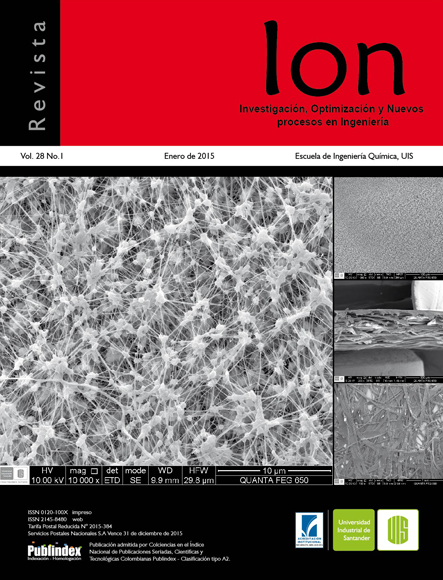Study of pitting corrosion resistance of austenitic stainless steels: influence of the manganese addition in solid solution
Published 2015-07-17
Keywords
- Pitting Corrosion,
- Manganese,
- Oxygen,
- Austenitic Stainless Steels.
How to Cite
Abstract
In this research are shown the results about the study of the influence of manganese in solid solution on the pitting corrosión resistance of austenitic stainless steels, a steel is referred to as 17Cr6Mn5Ni and the UNS S304L steel as benchmarking material. Electrolytic solution containing 0.6M NaCl in three different oxygen concentration were used (aerated, non aerated and naturally aerated). The behavior of each condition was measured through potentiodynamic polarization tests and metallographic examinations. The values of corrosion potential (Ecorr) and pitting potential (Ep) were determined. The oxygen concentration of the electrolytic solution influenced the Ecorr but not the Ep parameter.Manganese in solid solution benefits the Cl- ions absorption in austenitic stainless steels. Therefore, causes negative effect on pitting corrosion resistance. A mechanism was proposed through the standard Gibbs free energy of formation of compounds (∆G°) data, and through the competitive absorption theory.
Downloads
References
[2] London metal Exchange, LME Steel Billet price graph. Disponible en: http://www.lme.com/steel/steel_price_graphs.asp. Acceso el 15 de Agosto de 2012.
[3] Pecker D, Bernstein IM. Structure and Constitution of Wrought Austenitic Stainless Steels. En: Handbook of stainless steels. USA: McGraw-Hill; 1977. p. 35.
[4] Jian Xu, Xinqiang Wu, En-Hou Han. Acoustic emission response of sensitized 304 stainless steel during intergranular corrosion and stress corrosion cracking. Corrosion Science. 73;2013:262-73.
[5] Mc Gannon HE. The making, shaping and treating of steel. Pittsburg: United States Steel Corporation; 1964.
[6] Murgulescu JG, Radovici ZO. Uber die anodishe Passiviering einiger Chom-Nickel-Mangan-Stähle bei konstantem strom. Phys. Chem. 1960:214-88.
[7] Condylis A, Bayon F, Desestret A. Aciers inoxydables austénitiques au chrome-manganèse-azote. Revue de Metallurgie.1967:67.
[8] Shams AM, Madran MM, Khalil SE. Corrosio behavior of Manganese-Containig stainless steel. I. Galvanostatic Measurement in H2SO4Soplution. Werks.u.korros. 1973;24:576.
[9] Lunarska EZ, Szklarska-Smialowska, Janik-Czachor M. Susceptibility of Cr-Ni-Mn Stainless steel to Pitting In Choride Solution. Corrosion. 1975;31(7):231.
[10] Knyazheva VM, Vedeneesa MA, Esseldin-Halil S, Kolotyrkin YA. Zashchita Metallov. Vol. 1. 1965: 465.
[11] Wenming Tian, Nan Du, Songmei Li, Sibing Chen, Qunying Wu. Metastable pitting corrosion of 304 stainless steel in 3.5% NaCl solution. Corrosion Science. 2014;85:372-9.
[12] Alfonsson E, Qvafort R. Investigation of the applicability of some PRE expressions for austenitic stainless steels. Avesta Corrosion Management. 1992;1:1-6.
[13] Speidel MO. Nitrogen Containig Austenitic Stainless steel.Mat-wiss. U. Werkstoiftech. 2006;37(10):877.[14] Mitrovic-Scepanovic V, Brigman RJ. Effect of manganese on pitting properties of type 301 stainless steel. Corrosion. 1996;52(1):23-7.
[15] Park JO, Suter T, Bohni H. Role of manganese sulfide inclusions on pit initiation of super austenitic stainless steels. Corrosion. 2003;59(1):59-67.
[16] Eklund GS. Initiation of pitting at sulfide inclusions in stainless steel. Corrosion.1974;121(4):467-73.
[17] Szklarska-Smialowska Z. Influence of sulfide inclusions of the pitting corrosion of steels. Corrosion. 1972;28(10):388-96.
[18] Dowling NJE, Duret-Thual C, Auclair G, Audouard JP, Combrade P. Effect of complex inclusions on pit initiation in 18% chromium-8% nickel stainless steel types 303, 304, and 321. Corrosion. 1995;51(5):343-55.
[19] Kyung Jin Park, Hyuk Sang Kwon. Effects of Mn on the localized corrosion behavior of Fe–18Cr alloys. Electrochimica Acta. 2010;55:3421–7.
[20] Szklarska-Smialowska. Pitting and crevice corrosion. NACE International. HOUSTON, TEXAS. 2005: 559.[21] Fontana MG. Corrosion Engineering. 3. Ed. New York, McGraw-Hill; 1987.
[22] Weast R. Handbook of chemistry and physics 1st student edition. Florida. 1988.
[23] Wolynec S. Técnicas eletroquímicas em Corrosão. Escola Politécnica da Universidade de São Paulo. São Paulo. 2003.

